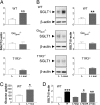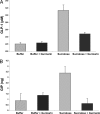T1R3 and gustducin in gut sense sugars to regulate expression of Na+-glucose cotransporter 1
- PMID: 17724332
- PMCID: PMC1986615
- DOI: 10.1073/pnas.0706678104
T1R3 and gustducin in gut sense sugars to regulate expression of Na+-glucose cotransporter 1
Abstract
Dietary sugars are transported from the intestinal lumen into absorptive enterocytes by the sodium-dependent glucose transporter isoform 1 (SGLT1). Regulation of this protein is important for the provision of glucose to the body and avoidance of intestinal malabsorption. Although expression of SGLT1 is regulated by luminal monosaccharides, the luminal glucose sensor mediating this process was unknown. Here, we show that the sweet taste receptor subunit T1R3 and the taste G protein gustducin, expressed in enteroendocrine cells, underlie intestinal sugar sensing and regulation of SGLT1 mRNA and protein. Dietary sugar and artificial sweeteners increased SGLT1 mRNA and protein expression, and glucose absorptive capacity in wild-type mice, but not in knockout mice lacking T1R3 or alpha-gustducin. Artificial sweeteners, acting on sweet taste receptors expressed on enteroendocrine GLUTag cells, stimulated secretion of gut hormones implicated in SGLT1 up-regulation. Gut-expressed taste signaling elements involved in regulating SGLT1 expression could provide novel therapeutic targets for modulating the gut's capacity to absorb sugars, with implications for the prevention and/or treatment of malabsorption syndromes and diet-related disorders including diabetes and obesity.
Conflict of interest statement
Conflict of interest statement: R.F.M. has a personal financial interest in the form of stock ownership in the Redpoint Bio company, receives consulting fees from the Redpoint Bio company, and is an inventor on patents and patent applications which have been licensed to the Redpoint Bio company. S.P.S.-B. is the inventor on the subject matter of this paper “intestinal glucose sensor,” which is protected by a patent filed with the European Patent Office, EP04077610.6 and the U.S. Patent and Trademark Office, PCT/EP2005/054760.
Figures




Comment in
-
Sweet taste signaling in the gut.Proc Natl Acad Sci U S A. 2007 Sep 18;104(38):14887-8. doi: 10.1073/pnas.0707410104. Epub 2007 Sep 12. Proc Natl Acad Sci U S A. 2007. PMID: 17855558 Free PMC article. No abstract available.
References
Publication types
MeSH terms
Substances
Grants and funding
LinkOut - more resources
Full Text Sources
Other Literature Sources
Medical
Molecular Biology Databases

